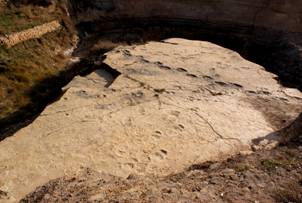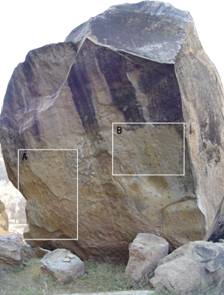陕西神木侏罗系恐龙足迹新发现及其地层学意义
发布时间:2012年03月07日 作者:张玉光
张玉光1)2) 李建军1) 胡松梅3) 张笠夫4) 刘迪1)
1)北京自然博物馆 北京 100050;
2)中国科学院脊椎动物进化系统学重点实验室 北京 100044;
3)陕西省考古研究院 西安 710054;
4)内蒙古鄂托克旗国土资源局 鄂托克旗 016100
摘 要:近两年,本文第三作者在进行文物普查时,于陕西神木县栏杆堡镇的两个村庄附近发现了大量的恐龙足迹化石。 这两处化石点不仅足迹数量多,而且种类也不尽相同,同以往该地的足迹类型相比,也存在明显的区别。此外,两处足迹化石点地层时代分属早侏罗世和中侏罗世,较之早期该地发现的足迹时代和省内其他地方的足迹时代都要早很多。文中就神木县新发现的恐龙化石足迹进行简单的报道,在对化石所在地层作对比的同时,还从地层纵向上对陕西神木的恐龙足迹化石分布展开探讨。
关键词:恐龙足迹,新类型,侏罗系,陕西神木
NEW DISCOVERY AND STRATIGRAPHIC SIGNIFICANCE OF DINOSAUR FOOTPRINTS FROM THE JURASSIC OF SHENMU COUNTY,
ZHANG Yu-guang1)2) LI Jian-jun1) HU Song-mei3) ZHANG Li-fu4) LIU Di1)
1)Beijing Museum of Natural History,Beijing 100050;
2)Key Laboratory of Evolutionary Systematics of Vertebrates,CAS,Beijing 10004;
3)Archaeological research institute of Shaanxi Province,Xi’an 710054;
4)The Bureau of Land and Resources of Otog Banner,Otog Banner 016100;
Abstract: The past two years, making this survey of cultural artifacts by the third author, a large number of dinosaur footprint fossils were discovered near the two villages of Langanbao, Shenmu County,Shaanxi Province. Fossil footprints of these two sites are not only abundant but also different from each other. There were obvious differences by comparing previous fossil footprints with these fossils. In addition, the strata of two footprint sites belong to the early and middle Jurassic, earlier than the era of the previous discovery of footprints and the footprints of other parts of the
Key words: Dinosaur footprints, the new type, Jurassic,


图1 陕西神木县邱井沟村恐龙足迹保留的砂岩面 图2 陕西神木县邱井沟村恐龙足迹线描图
Fig. 1 Dinosaur footprints preserved on sandstone surface in Qiujinggou village,
Fig. 2 Dinosaur footprints line drawing map in Qiujinggou village,


图3 陕西神木县李家南瓦村一坠石上的恐龙足迹 图4 陕西神木县李家南瓦村一坠石上局部恐龙足迹(A)
Fig. 3 Dinosaur footprints on a falling stone in Lijiananwa village,
Fig. 4 Part of dinosaur footprints on a stone in Lijiananwa village, Shenmu County (A)

图5 陕西神木县李家南瓦村一坠石上局部恐龙足迹(B)
Fig. 5 Part of dinosaur footprints on a stone in Lijiananwa village, Shenmu County (B)
发表于2012年《地层学杂志》36(1):60-64



 京公网安备11010102006642号
京公网安备11010102006642号